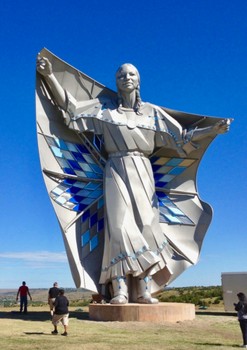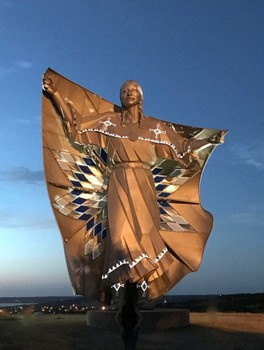Dignity Statue
Introduction
Text-to-speech Audio
The Dignity Statue in South Dakota is a 50 foot statue that stands tall and proud over the South Dakota interstate. Norm McKie donated the $1 million to have the statue built as a gift for South Dakota's 125th year of statehood. Lamphere decided to create a beautiful sculpture of a Native American woman who appears to be of the Lakota tribe. The statue can be seen by passerbys on the interstate both at night and during the day. The statue is equipped with lights that light up the statue when it gets dark outside, making viewing of the statue at any time just as enjoyable.
Images
Dignity Statue

Dignity at Night

Backstory and Context
Text-to-speech Audio
The Dignity Statue was built in 2016 with a $1 million donation given by Norm and Eunabel McKie. The project was given to a local sculptor, Dale Lamphere, to complete. The statue took Lamphere and his team from the summer of 2015 to September 17, 2016 to finish the sculpture. The final product ended up being 50 feet tall, towering over the highway in Chamberlain, South Dakota. The sculpture seems to depict a woman of the Lakota tribe holding up a star quilt behind her back. The star on the quilt represents what is the morning star to the Lakota, and this symbolizes "the direction from which spirits travel to Earth and is a link between the living and the dead (in extension), thus symbolizing immortality" (Owinja par. 5). Norm McKie was inducted into the South Dakota Hall of Fame for his generosity in donations to an altitude of places, including the Oglala Sioux Tribe, which is the same tribe that Dignity resembles being from.
The Sioux Indians were part of one of the most tragic events in South Dakota history, the Wounded Knee massacre. This tragedy was an offset of disregard for the Natives or their culture. The Natives attempted to prevent the white settlers from claiming their land, and the United States government signed treaties with the Natives to designate them their own land. The 1868 Treaty of Fort Laramie was the most notable treaty from this time, promising the Natives a 60 million acre reservation. The government provided food in return for their compliance, staying in the reservation and leaving the white settlers alone. The United States, however, proceeded to violate this treaty with the reservation shrinking to just 12.7 million acres by 1887. On top of this, the government forced the Lakota to adopt Christianity, dress more like whites, and encouraged them to farm instead of hunt. The smaller amount of land and adoption of white culture had the Lakota relying on the government provided food until the government decided to stop providing food for them in 1889.
All of this led to a panic from the Sioux Indians. They could not hunt in the amount of land allotted, so they began to starve. Eventually the natives began relying on the "Ghost Dance" after a Pauite prophet, Wovoka, had a vision where the tribe met salvation after staying peaceful and continuously doing this dance. A federal agent observed this dance, and he assumed it to be a war dance. After being informed of this, the president, Benjamin Harrison sent out troops. A Ghost Dance leader, Sitting Bull, was killed at Standing Rock. Upon hearing this news, the Lakota leader, Big Foot, feared for the lives of his people. It is believed that the Lakota were told by a federal agent that the Lakota would be taken prisoner and deported. In the name of preserving their culture peacefully, Big Foot tried to lead his tribe to safety in Pine Ridge. Instead, however, the tribe was stopped and put into a camp. They were forced to give up their weapons. The Lakota desperately began dancing once again, and on December 29, 1890, when a man named Black Coyote refused to give up his weapon, there was a struggle to get his gun. The gun was accidentally fired and this led to the troops firing back. This resulted in the deaths of at least 250 Lakotas but 25 soldiers. At the time, the event was far from being seen as a tragedy. As a matter of fact, 20 of these soldiers received Congressional Medals of Honor (which later were revoked).
In 1973, 83 years after the Wounded Knee Massacre, activists took to this site to bring attention to the violations of civil rights that the Sioux Indians had to endure. "They declared it the 'Independent Oglala Sioux Nation' and refused to leave until the U.S. federal government ousted the presiding Sioux chairman, promised to honour all Indian treaties, and corrected the treatment of American Indians throughout the country.” The activists hoped that their movement would encourage the cease of government seizing Indian land for resources. The Dignity statue serves as a reminder to Americans and ensures that the Sioux tribes will not be forgotten. The morning star on Dignity's quilt shows the immortality of the Lakota in Chamberlain, South Dakota. Dale Lamphere says, "[Native Communities] are such a big part of our culture and this is meant to honor them and to acknowledge them and to inspire the future generations both native and non native".
Sources
Owinja - Star Quilt, Akta Lakota Museum and Cultural Center. Accessed October 17th 2019. http://aktalakota.stjo.org/site/News2?page=NewsArticle&id=8594.
Hudson, Myles. Wounded Knee Massacre, Encyclopaedia Britannica. September 16th 2019. Accessed October 17th 2019. https://www.britannica.com/event/Wounded-Knee-Massacre.
Gonzalez, Carlos O. 'Dignity' a statue of unity and peace, KSFY. September 17th 2016. Accessed October 17th 2019. https://www.ksfy.com/content/news/Dignity-a-statue-of-unity-and-peace--393855011.html.
McKie, Norm. The Statue Dignity, South Dakota Hall of Fame. September 2nd 2015. Accessed October 17th 2019. http://sdexcellence.org/The_Statue_Dignity.
Legacy Norm McKie, South Dakota Hall of Fame. Accessed October 17th 2019. http://sdexcellence.org/Norm_McKie_2011.
American Indian Movement, Encyclopaedia Britannica. Accessed October 17th 2019. https://www.britannica.com/topic/American-Indian-Movement.
Lamphere, Dale Claude. Dignity, D. C. Lamphere Studio. Accessed October 17th 2019. https://lampherestudio.com/dignity/.
Wounded Knee Massacre, Encyclopedia of the Great Plains. Accessed October 17th 2019. http://plainshumanities.unl.edu/encyclopedia/doc/egp.war.056.
https://lampherestudio.com/dignity/
https://lampherestudio.com/dignity/
